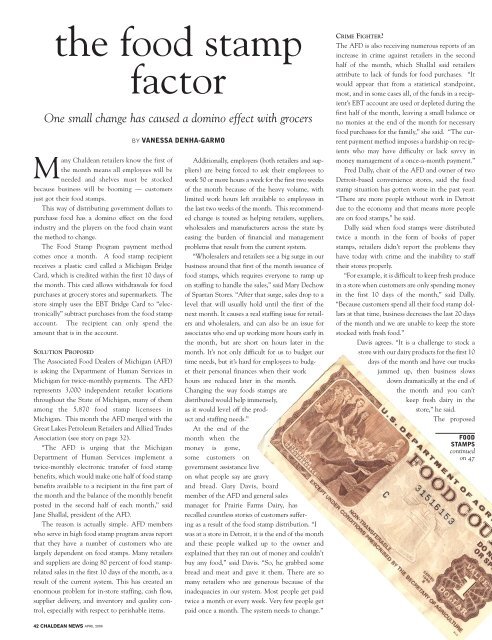APRIL 2006
cn0406_0156
cn0406_0156
You also want an ePaper? Increase the reach of your titles
YUMPU automatically turns print PDFs into web optimized ePapers that Google loves.
the food stamp<br />
factor<br />
One small change has caused a domino effect with grocers<br />
Many Chaldean retailers know the first of<br />
the month means all employees will be<br />
needed and shelves must be stocked<br />
because business will be booming — customers<br />
just got their food stamps.<br />
This way of distributing government dollars to<br />
purchase food has a domino effect on the food<br />
industry and the players on the food chain want<br />
the method to change.<br />
The Food Stamp Program payment method<br />
comes once a month. A food stamp recipient<br />
receives a plastic card called a Michigan Bridge<br />
Card, which is credited within the first 10 days of<br />
the month. This card allows withdrawals for food<br />
purchases at grocery stores and supermarkets. The<br />
store simply uses the EBT Bridge Card to “electronically”<br />
subtract purchases from the food stamp<br />
account. The recipient can only spend the<br />
amount that is in the account.<br />
SOLUTION PROPOSED<br />
The Associated Food Dealers of Michigan (AFD)<br />
is asking the Department of Human Services in<br />
Michigan for twice-monthly payments. The AFD<br />
represents 3,000 independent retailer locations<br />
throughout the State of Michigan, many of them<br />
among the 5,870 food stamp licensees in<br />
Michigan. This month the AFD merged with the<br />
Great Lakes Petroleum Retailers and Allied Trades<br />
Association (see story on page 32).<br />
“The AFD is urging that the Michigan<br />
Department of Human Services implement a<br />
twice-monthly electronic transfer of food stamp<br />
benefits, which would make one half of food stamp<br />
benefits available to a recipient in the first part of<br />
the month and the balance of the monthly benefit<br />
posted in the second half of each month,” said<br />
Jane Shallal, president of the AFD.<br />
The reason is actually simple. AFD members<br />
who serve in high food stamp program areas report<br />
that they have a number of customers who are<br />
largely dependent on food stamps. Many retailers<br />
and suppliers are doing 80 percent of food stamprelated<br />
sales in the first 10 days of the month, as a<br />
result of the current system. This has created an<br />
enormous problem for in-store staffing, cash flow,<br />
supplier delivery, and inventory and quality control,<br />
especially with respect to perishable items.<br />
BY VANESSA DENHA-GARMO<br />
Additionally, employers (both retailers and suppliers)<br />
are being forced to ask their employees to<br />
work 50 or more hours a week for the first two weeks<br />
of the month because of the heavy volume, with<br />
limited work hours left available to employees in<br />
the last two weeks of the month. This recommended<br />
change is touted as helping retailers, suppliers,<br />
wholesalers and manufacturers across the state by<br />
easing the burden of financial and management<br />
problems that result from the current system.<br />
“Wholesalers and retailers see a big surge in our<br />
business around that first of the month issuance of<br />
food stamps, which requires everyone to ramp up<br />
on staffing to handle the sales,” said Mary Dechow<br />
of Spartan Stores. “After that surge, sales drop to a<br />
level that will usually hold until the first of the<br />
next month. It causes a real staffing issue for retailers<br />
and wholesalers, and can also be an issue for<br />
associates who end up working more hours early in<br />
the month, but are short on hours later in the<br />
month. It’s not only difficult for us to budget our<br />
time needs, but it’s hard for employees to budget<br />
their personal finances when their work<br />
hours are reduced later in the month.<br />
Changing the way foods stamps are<br />
distributed would help immensely,<br />
as it would level off the product<br />
and staffing needs.”<br />
At the end of the<br />
month when the<br />
money is gone,<br />
some customers on<br />
government assistance live<br />
on what people say are gravy<br />
and bread. Gary Davis, board<br />
member of the AFD and general sales<br />
manager for Prairie Farms Dairy, has<br />
recalled countless stories of customers suffering<br />
as a result of the food stamp distribution. “I<br />
was at a store in Detroit, it is the end of the month<br />
and these people walked up to the owner and<br />
explained that they ran out of money and couldn’t<br />
buy any food,” said Davis. “So, he grabbed some<br />
bread and meat and gave it them. There are so<br />
many retailers who are generous because of the<br />
inadequacies in our system. Most people get paid<br />
twice a month or every week. Very few people get<br />
paid once a month. The system needs to change.”<br />
CRIME FIGHTER?<br />
The AFD is also receiving numerous reports of an<br />
increase in crime against retailers in the second<br />
half of the month, which Shallal said retailers<br />
attribute to lack of funds for food purchases. “It<br />
would appear that from a statistical standpoint,<br />
most, and in some cases all, of the funds in a recipient’s<br />
EBT account are used or depleted during the<br />
first half of the month, leaving a small balance or<br />
no monies at the end of the month for necessary<br />
food purchases for the family,” she said. “The current<br />
payment method imposes a hardship on recipients<br />
who may have difficulty or lack savvy in<br />
money management of a once-a-month payment.”<br />
Fred Dally, chair of the AFD and owner of two<br />
Detroit-based convenience stores, said the food<br />
stamp situation has gotten worse in the past year.<br />
“There are more people without work in Detroit<br />
due to the economy and that means more people<br />
are on food stamps,” he said.<br />
Dally said when food stamps were distributed<br />
twice a month in the form of books of paper<br />
stamps, retailers didn’t report the problems they<br />
have today with crime and the inability to staff<br />
their stores properly.<br />
“For example, it is difficult to keep fresh produce<br />
in a store when customers are only spending money<br />
in the first 10 days of the month,” said Dally.<br />
“Because customers spend all their food stamp dollars<br />
at that time, business decreases the last 20 days<br />
of the month and we are unable to keep the store<br />
stocked with fresh food.”<br />
Davis agrees. “It is a challenge to stock a<br />
store with our dairy products for the first 10<br />
days of the month and have our trucks<br />
jammed up, then business slows<br />
down dramatically at the end of<br />
the month and you can’t<br />
keep fresh dairy in the<br />
store,” he said.<br />
The proposed<br />
FOOD<br />
STAMPS<br />
continued<br />
on 47<br />
42 CHALDEAN NEWS <strong>APRIL</strong> <strong>2006</strong>

















